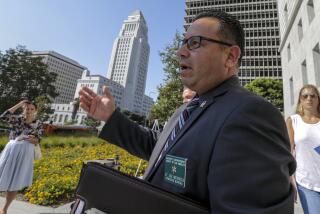A Rate Increase That Must Be Faced : Council can’t avoid raising sewer rates to make court-ordered fixes on system
The San Diego City Council has little choice but to approve the next round of sewer rate increases. Hanging over its head is the possibility of being held in contempt of court if it doesn’t.
The increases, which would more than double sewer rates by 2003, are needed to continue upgrading the aging sewer system, to start building the region’s water reclamation system and to improve sewage treatment, as required by the Clean Water Act.
The city has been under the supervision of a federal judge because of years of complacency that resulted in hundreds of sewage spills, and a reluctance to upgrade sewage treatment.
A consent decree the city agreed to with the state and federal governments requires a timetable for improving the system, and the rate increases are needed for pay them.
A “doubling” of rates sounds more dramatic than it is: The average San Diego city household pays $19.24 a month for sewer service.
That’s an average of 64 cents a day to treat everything that is flushed down the toilet or ground up in the garbage disposal or poured down the drain.
That’s a pretty good deal.
Next year, if the new rates are approved, the bill would be $22.13 a month, an increase of $2.89.
That’s still only 73 cents a day.
A decade later, the rates would be $45.06 a month--less than the average household’s gas and electric bill today.
San Diego needs the reclamation system to help meet its water needs in the 21st Century.
Just a year ago, the region was facing the prospect of 50% cutbacks in water, and Los Angeles was reminding San Diego that Los Angeles owns the rights to significant amounts of the water San Diego uses.
That’s a strong reason to pay for sewer improvements and reclamation.
The 180 million gallons of partly treated sewage that is flowing each day into near-shore ocean waters, fouling the region’s beaches is a reminder of why it needs sewer system improvements.
Although the cause of the spill has yet to be determined, the effect is clear.
And this is just the most dramatic spill. Spills have been closing San Diego beaches for years, damaging the area’s reputation.
There are reasons that San Diego’s sewage system is being monitored by the federal courts: It was neglected for too many years.
But there are still many questions about how much money is needed for the overall project, whether the money is being spent most efficiently and why the cost is not being spread among the other 15 other communities that use the system.
These need clear answers, and a consensus must finally be reached on the issue among San Diego’s leaders.
This may be nearly impossible until the court case is settled and a new mayor is elected.
But, until the confusion is cleared up, the City Council will continue getting caught between a disapproving court and a disbelieving public.
More to Read
Start your day right
Sign up for Essential California for news, features and recommendations from the L.A. Times and beyond in your inbox six days a week.
You may occasionally receive promotional content from the Los Angeles Times.





